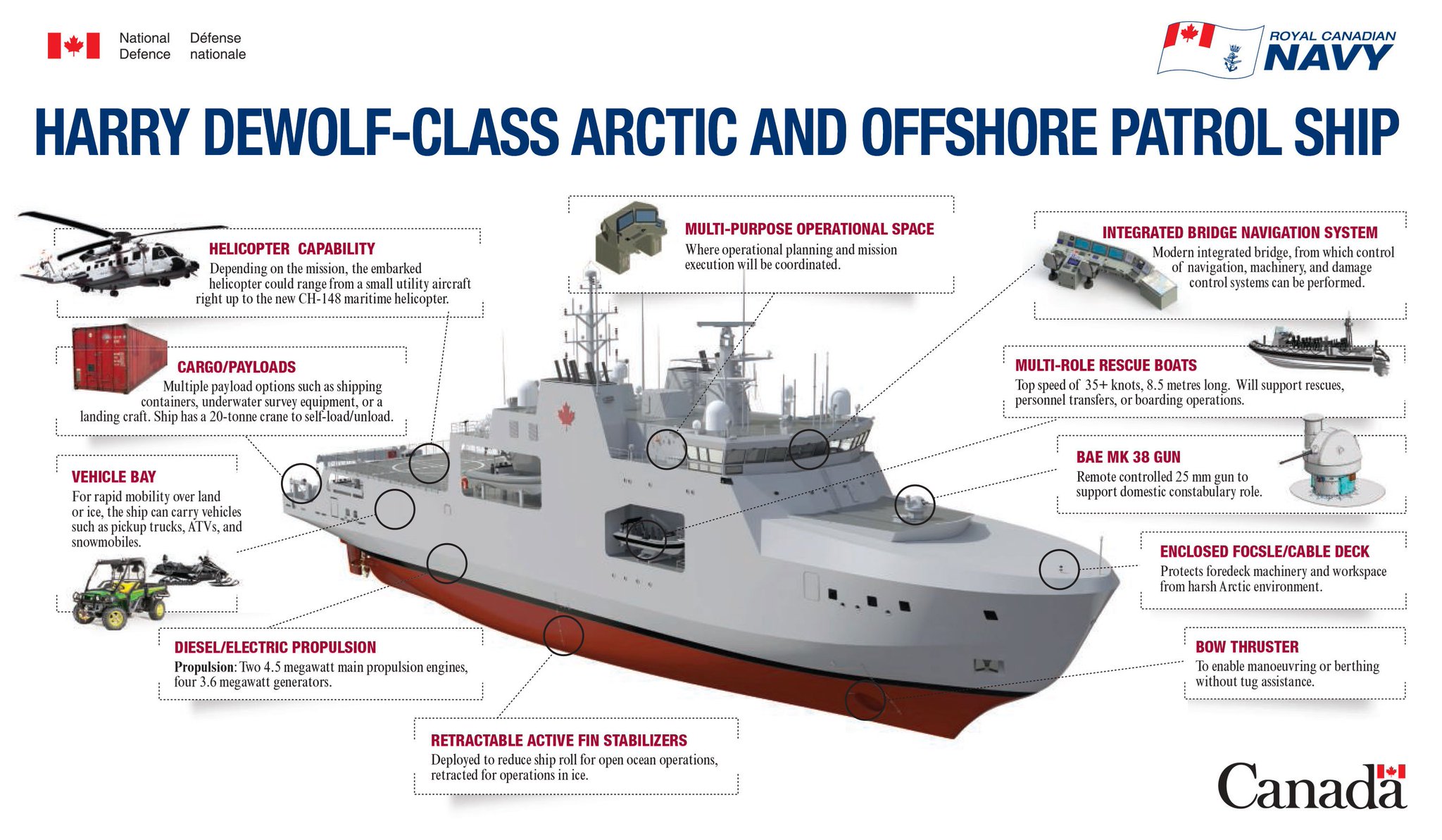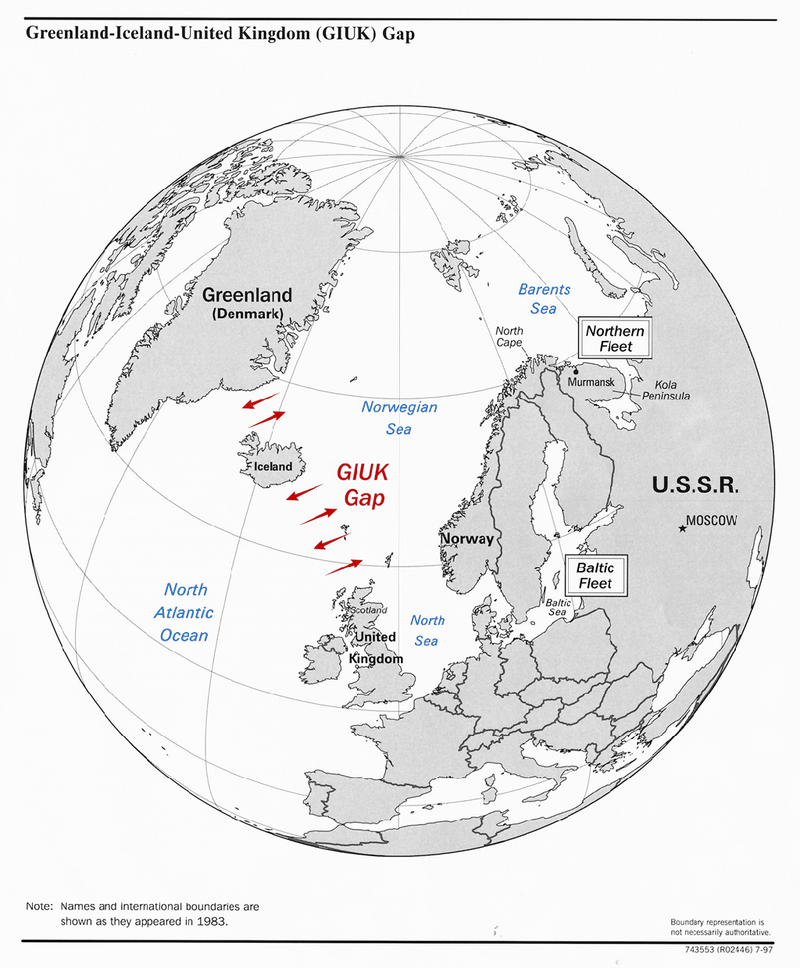Colin Parkinson
Army.ca Myth
- Reaction score
- 11,929
- Points
- 1,160
Info graphic on the ship via Irving twitter




Dolphin_Hunter said:It’s a cool badge for sure.
Sadly, I think it’s better suited for a warship and not a beefed up Coast Guard Vessel.
Underway said:As ships badges go it's amazing. Wolf with a sword? Yes please! Any word on the motto?
Chief Engineer said:I noticed that in the latest from the RCN it lists the icebreaking capability at 120cm vice 100 . That makes the ship a PC5 plus or closer to a PC4.
MilEME09 said:How high north would a PC5 be able to go in winter? These are arctic patrol ships but how far into the arctic can they actually go?
Colin P said:https://www.vermilionstandard.com/news/national/smol-naval-ships-all-sight-no-fight/wcm/996fa5b7-99cc-4ee0-96dd-f807dee2feb3
Certainly not the Canadian way of coastal defence, eh! - snip
MilEME09 said:How high north would a PC5 be able to go in winter? These are arctic patrol ships but how far into the arctic can they actually go?
Colin P said:https://www.vermilionstandard.com/news/national/smol-naval-ships-all-sight-no-fight/wcm/996fa5b7-99cc-4ee0-96dd-f807dee2feb3
Snip- Though slightly smaller than Canada’s Arctic patrol ships, the Royal Danish Navy’s vessels are armed with an Otobreda 76-mm main gun as well as two 12.7-mm Browning machine guns. The Danish patrol ships are also fitted to fire Evolved Sea Sparrow Missiles (ESSM) and have torpedoes. These Danish ships are equipped to protect themselves if necessary.
And while Canada’s Arctic ships are still a long way to being fully operational, two of Denmark’s three Arctic patrol ships have been active off the of Greenland over the last two months. These three Danish patrol ships are only a small part of the country’s recently completed fleet modernization.
Elsewhere tiny, social democratic Norway’s answer to its coastal defence challenges is represented, in part, by its fleet of six ultra-fast Skjold Stealth Missile Corvettes each one wielding a 76-mm cannon, eight Kongsberg surface to surface missiles, plus additional Mistral Surface to Air Missile system. The ship also has the Kongsberg M151 Protector Remote Weapon Station, and two 12.7mm machine guns. Certainly not the Canadian way of coastal defence, eh! - snip

Humphrey Bogart said:And none of this matters one bit for us. None of those ships can sail anywhere our current fleet of ships can't sail and it really doesn't matter anyways as they don't really have any real capabilities other than self-defence, those ships wouldn't last a second against a modern nuclear submarine and would make for some nice target practice. The AOPV is perfect for constabulary missions in our territorial waters and if we wanted complete coverage of our Arctic Waters, the only real option is Nuclear Submarines. Actual military defence of our Arctic Waters is fairly straight forward and a simple FLOCARK (I don't know what the Navy uses for terrain analysis but I am certain they have a similar procedure for Charts) shows that it is fairly defensible terrain from a Naval standpoint:

There are really two ways to get in to our Arctic:
#1: Sail past Alert in to Baffin Bay; and
#2: Through the Northwest Passage, either Straight in to Baffin Bay or head around the South side of Baffin Island (Improbable due to how canalizing the waterway is and I am certain it isn't very deep there).
The great thing about our Arctic Archipelago is that all roads lead to the Davis Strait, a lot of which doesn't freeze over and is in fact open water. You could set up a picket line from Greenland to Northern Quebec and have a pretty good idea of what is happening in our Arctic as what goes in must come out and it all leads to one spot. Setting up Passive and Active Sensors in those two areas would give you early warning capability as well so you could surge out of Halifax if required.
The real danger if we are talking conventional warfare and not full scale nuclear warfare (we are fubared anyways if this is the case) is an adversary getting submarines in to Hudson Bay and and using that entire body of water as a gigantic staging area to launch a massive cruise missile strike. A conventional submarine armed with Kalibr Missiles could strike Washington from Hudson Bay with gas in the rocket to spare. Heck you could even insert SOF clandestinely there and go run roughshod over our entire Hydro Generating Capacity along James Bay and take down the entire Power Grid along the Eastern Seaboard, it would be impossible to find them and there is nobody up there to stop them causing havoc anyways.
The only real option to defend our Arctic if we actually wanted to and didn't cede that duty to the Americans would be to procure a fleet of nuclear submarines though so this is really an exercise in futility.
Colin P said:I suspect the most likely scenario is we discover a manned "research station" with armed guards and well armed ship protecting it or "polite armed men in whilte camo". How do we react if they ignore diplomatic efforts?
Colin P said:... I suspect the most likely scenario is we discover a manned "research station" with armed guards and well armed ship protecting it or "polite armed men in whilte camo". How do we react if they ignore diplomatic efforts?
Colin P said:I think you find the terrain and weather friction far more of a factor than anywhere else. Arctic warfare is likely 7/10th survival, 2/10th finding the enemy and 1/10th fighting. Attempts to place shallow water sensor nets for whales have failed, any sensor net needs to be deep to avoid ice damage, but then it needs to be able to reach the surface to get power/transmit. You need a shore station either remote or manned to operate them, if remote, be prepared not to be able to fix problems for weeks, even a whole season. We also have limited supply depots as well. I suspect the most likely scenario is we discover a manned "research station" with armed guards and well armed ship protecting it or "polite armed men in whilte camo". How do we react if they ignore diplomatic efforts?

Colin P said:I don’t mean to dis-respect people, but I really see a “beaten wife syndrome” in the forces, the fight to maintain any capability in the face of either wilful disdain or outright hostility from successive governments has so conditioned people into an acceptance of inadequate resources and defense of that inadequacy that is not entirely rational. I can’t fathom any rational argument to build a naval ship the size of the AOPs without the means to project power or defend itself, while other allied navies using similar ships do. Going by our history, these ships will be called upon to do far more than we ever envisioned and we are not setting up the future crews for success.


